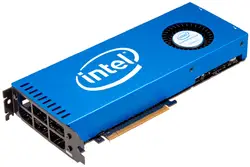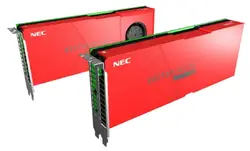| Line 1: | Line 1: | ||
{{title|Accelerator Card}} | {{title|Accelerator Card}} | ||
| + | [[File:knights ferry accelerator card.png|right|250px|thumb|Intel's {{intel|Knights Ferry|l=arch}} accelerator card featuring 72 [[x86]] cores for accelerating massively parallel workloads.]] | ||
| + | [[File:nec vector engine accelerator.png|right|250px|thumb|NEC's vector engine accelerator card featuring 8 cores each capable of 307 GFLOPS/core for accelerating vector processing.]] | ||
'''Accelerator cards''' are specialty [[expansion card]]s designed primarily for the acceleration of specialized workloads such as vector operation acceleration, [[artificial neural network|ANN]] acceleration, and cryptographic acceleration. | '''Accelerator cards''' are specialty [[expansion card]]s designed primarily for the acceleration of specialized workloads such as vector operation acceleration, [[artificial neural network|ANN]] acceleration, and cryptographic acceleration. | ||
| − | + | == Overview == | |
| + | Accelerator cards are a special type of [[expansion cards]] designed specifically for the purpose of accelerating various workloads. Generally those cards are plugged via a PCIe slot and are seen as a standard PCIe devices by the [[host processor]]. Using special library code, usually provided by the card manufacturer, programs can instruct the accelerator card to perform various operations. Those operations are then performed by the card and the result is sent back to the host processor. | ||
| + | Typically, but not always, accelerator cards make use of custom [[ASIC]] chips (known as ''[[accelerators]]'') in order to execute such workloads far more efficiently than what a normal [[general-purpose microprocessor]] would be capable of. Typically, those operations are done quicker ("accelerated") on the card than the processor could perform on its own because the accelerator incorporate specialized logic to perform a set of complex operations in a way that cannot be implemented in software as easily or as efficiently. Various [[FPGA]]-based accelerator cards also exist allowing the user to implement his own [[hardware acceleration]] functions. | ||
| + | |||
| + | == Types == | ||
Types of accelerator cards: | Types of accelerator cards: | ||
| Line 11: | Line 17: | ||
** SSL Accelerator Cards | ** SSL Accelerator Cards | ||
* DSP Accelerator Cards | * DSP Accelerator Cards | ||
| + | * FPGA Accelerator Cards | ||
* Graphics Accelerator Cards | * Graphics Accelerator Cards | ||
* Vector Accelerator Cards | * Vector Accelerator Cards | ||
[[Category:hardware acceleration]] | [[Category:hardware acceleration]] | ||
Revision as of 00:19, 19 November 2017

Accelerator cards are specialty expansion cards designed primarily for the acceleration of specialized workloads such as vector operation acceleration, ANN acceleration, and cryptographic acceleration.
Overview
Accelerator cards are a special type of expansion cards designed specifically for the purpose of accelerating various workloads. Generally those cards are plugged via a PCIe slot and are seen as a standard PCIe devices by the host processor. Using special library code, usually provided by the card manufacturer, programs can instruct the accelerator card to perform various operations. Those operations are then performed by the card and the result is sent back to the host processor.
Typically, but not always, accelerator cards make use of custom ASIC chips (known as accelerators) in order to execute such workloads far more efficiently than what a normal general-purpose microprocessor would be capable of. Typically, those operations are done quicker ("accelerated") on the card than the processor could perform on its own because the accelerator incorporate specialized logic to perform a set of complex operations in a way that cannot be implemented in software as easily or as efficiently. Various FPGA-based accelerator cards also exist allowing the user to implement his own hardware acceleration functions.
Types
Types of accelerator cards:
- AI Accelerator Cards
- Compression Accelerator Cards
- Cryptographic Accelerator Cards
- SSL Accelerator Cards
- DSP Accelerator Cards
- FPGA Accelerator Cards
- Graphics Accelerator Cards
- Vector Accelerator Cards
